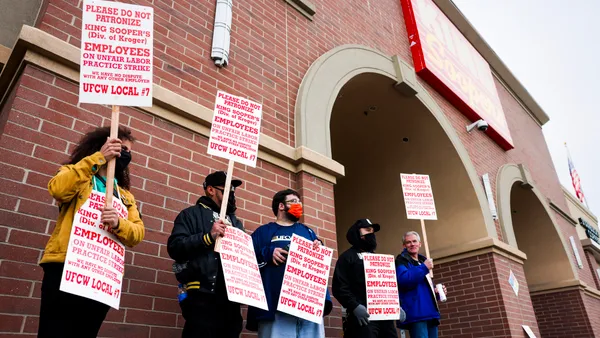Dive Brief:
- Sprouts Farmers Market recorded sales of $1.6 billion in the third quarter, a 9.5% increase over the same period in 2019, the natural foods grocery chain reported Wednesday. The company posted net income of $60 million during the 13-week period, which concluded Sept. 27, up 138% compared with 2019's Q3.
- Comparable store sales for the grocery were up 4.2% in Q3 on a year-over-year basis, and the company expects comp growth to be in “the low single digits” in the fourth quarter. E-commerce sales grew 337% and represented 11% of Sprouts’ sales during Q3.
- Sprouts’ sales growth is not as robust as what its competitors have seen in recent months, but company executives remain optimistic that their sharp focus on health-conscious consumers will pay off in future quarters.
Dive Insight:
Speaking Wednesday during Sprouts’ earnings call, the grocer’s CEO, Jack Sinclair, said he is not concerned that Sprouts’ comparable store sales growth was slower than that of other grocers. The specialty chain, he said, is focused on bringing in the minority of customers who are intensely interested in its health-conscious assortment.
“The reality is we're playing our own game in the middle of this pandemic. And it's something that we outlined well before the COVID dynamics created a little bit of confusion,” Sinclair said. “We are very set on the strategy that we've outlined, which is targeting specific customers, targeting a more narrow customer base than trying to appeal to all people all times … we're very comfortable that that strategy is working well for us.”
In a note to clients, R5 Capital analysts Scott Mushkin and Matt Siler said Sprouts will face challenges as it looks to recapture its past success as a grocer heavily focused on providing shoppers with high-quality fresh produce at low prices. “We view the slow comp growth as evidence that there remains a lot of work ahead for the new management team. Our research suggests that a farm-fresh, small box specialty food retailer likely has broad appeal, but getting the formula right across a multi-regional store footprint is not a small task,” the analysts wrote.
Sinclair said the size of customers’ baskets gives the company confidence that it is connecting with the consumers it wants to reach. “The people that we are targeting truly love Sprouts, and we just need to communicate to more of those types of people what the opportunity is if they come into Sprouts and go forward on that,” he said.
Sprouts is continuing to develop and emphasize the aspects of its assortment that stand out as it looks to attract customers, according to Sinclair. The company is highlighting differentiators like the ingredients in its products, where they come from and how its suppliers treat livestock, he said. Sprouts is also focusing on plant-based and frozen foods, categories where it believes it is particularly strong.
In addition, Sprouts plans to reserve space in its new stores specifically to highlight ways it differs from other grocers. “I'd like to see that kind of level of innovation coming in and out to constantly create interest” for customers, Sinclair said. “I think we can be the destination for the kind of healthy and diet focused innovation customer across the marketplace.”
Purchases by shoppers the company categorizes as highly price sensitive slowed during the third quarter, a development the company anticipated, Chief Financial Officer Denise Paulonis said during the call.
The company also did not capitalize on the trend toward trip consolidation that has benefited other supermarket operators, which Paulonis said was due to the fact that Sprouts carries fewer of the CPG items, such as paper goods and cleaning supplies, that shoppers have been seeking. Another factor is that the company’s stores are located in areas where credit card data indicates food-at-home growth was slower, Paulonis said.
Sinclair pointed to Sprouts’ fast-growing online sales as an indication the company is resonating with consumers, and called attention to its unique strategy for managing the digital business. Under that approach, Sprouts uses order-management technology from Instacart and depends on the e-commerce provider to handle deliveries to customers but uses its own employees to pick orders.
The grocer began taking orders for delivery and pickup through its own website and app during Q3, allowing customers to place orders directly with the company. The system relies on technology from Instacart but enables the grocer to better control the relationship with shoppers and collect more data than it could before, Sinclair said. Customers do not need accounts with Instacart to use the service.
Sinclair said Sprouts remains committed to its goal of doubling sales over five years, but acknowledged that achieving that milestone will require continued adjustments.
“We are in the early stages of brand development, but I’m pleased with the initial response. The opportunity lies with us to properly communicate and grow our target customers and their baskets over time,” Sinclair said. “We’re a $6 billion grocer in a $1.2 trillion market. We only need a small portion of market share to double in size."













